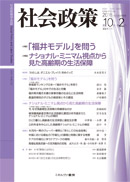Volume 10, Issue 2
Displaying 1-20 of 20 articles from this issue
- |<
- <
- 1
- >
- >|
Foreword
-
2018Volume 10Issue 2 Pages 1-7
Published: October 30, 2018
Released on J-STAGE: October 30, 2020
Download PDF (645K)
Special Report1 : Verification of the "Model of Fukui, " a Prefecture Ranked 1st on the Happiness Ranking
-
2018Volume 10Issue 2 Pages 5-7
Published: October 30, 2018
Released on J-STAGE: October 30, 2020
Download PDF (598K) -
2018Volume 10Issue 2 Pages 8-22
Published: October 30, 2018
Released on J-STAGE: October 30, 2020
Download PDF (1325K) -
2018Volume 10Issue 2 Pages 23-39
Published: October 30, 2018
Released on J-STAGE: October 30, 2020
Download PDF (1061K) -
2018Volume 10Issue 2 Pages 40-51
Published: October 30, 2018
Released on J-STAGE: October 30, 2020
Download PDF (758K)
Special Report2 : Livelihood Protection of the Elderly and National Minimum
-
2018Volume 10Issue 2 Pages 52-54
Published: October 30, 2018
Released on J-STAGE: October 30, 2020
Download PDF (605K) -
2018Volume 10Issue 2 Pages 55-67
Published: October 30, 2018
Released on J-STAGE: October 30, 2020
Download PDF (1174K) -
2018Volume 10Issue 2 Pages 68-81
Published: October 30, 2018
Released on J-STAGE: October 30, 2020
Download PDF (1021K) -
2018Volume 10Issue 2 Pages 82-92
Published: October 30, 2018
Released on J-STAGE: October 30, 2020
Download PDF (1196K)
Articles
-
2018Volume 10Issue 2 Pages 93-104
Published: October 30, 2018
Released on J-STAGE: October 30, 2020
Download PDF (814K) -
2018Volume 10Issue 2 Pages 105-116
Published: October 30, 2018
Released on J-STAGE: October 30, 2020
Download PDF (1021K) -
2018Volume 10Issue 2 Pages 117-128
Published: October 30, 2018
Released on J-STAGE: October 30, 2020
Download PDF (825K) -
Inversion of Public Attitudes toward Support for High―Benefit/High―Cost Practices in Social Benefits2018Volume 10Issue 2 Pages 129-141
Published: October 30, 2018
Released on J-STAGE: October 30, 2020
Download PDF (904K)
Book Reviews
-
2018Volume 10Issue 2 Pages 142-144
Published: October 30, 2018
Released on J-STAGE: October 30, 2020
Download PDF (819K) -
2018Volume 10Issue 2 Pages 144-148
Published: October 30, 2018
Released on J-STAGE: October 30, 2020
Download PDF (826K) -
2018Volume 10Issue 2 Pages 148-151
Published: October 30, 2018
Released on J-STAGE: October 30, 2020
Download PDF (823K)
-
2018Volume 10Issue 2 Pages 152-156
Published: October 30, 2018
Released on J-STAGE: October 30, 2020
Download PDF (434K) -
2018Volume 10Issue 2 Pages 157-159
Published: October 30, 2018
Released on J-STAGE: October 30, 2020
Download PDF (595K) -
2018Volume 10Issue 2 Pages 160-161
Published: October 30, 2018
Released on J-STAGE: October 30, 2020
Download PDF (583K) -
2018Volume 10Issue 2 Pages Cover2-
Published: October 30, 2018
Released on J-STAGE: October 30, 2020
Download PDF (3465K)
- |<
- <
- 1
- >
- >|
